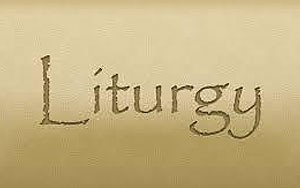


Liturgy
"We have seen the true Light, we have received the heavenly Spirit; we have found the true Faith, worshiping the undivided Trinity: forHe has saved us."The Liturgy of St. John Chrysostom
THE MEANING OF THE LITURGY
When Moses led the people of Israel out of Egypt, he was given a very explicit set of instructions on how they were to worship the God who freed them. These instructions were revealed by God on Mount Sinai and are found in the books of Exodus, Leviticus, Numbers and Deuteronomy in the Old Testament. From this beginning arose the complex liturgical Temple worship of ancient Israel.
In the New Testament, we find that Jesus’ disciples, who were all Jewish, at first continued to worship in the
Temple and afterwards gathered at a private home to celebrate the particularly Christian “breaking of bread,” the
Holy Eucharist.
1.Christian life at that time is described in the Book of Acts as continuing “steadfastly in the apostle’s doctrine and fellowship, in the breaking of bread, and in the prayers
2. Christians would “break bread” on the first day of the week, the day the Lord had risen from the dead.
3. Christians came to see their worship as the legitimate maturation of the worship given to Moses, supplanting the
cult of the Temple in Jerusalem. Inas much as Christ had established a better covenant between God and the fallen
world, He obtained for us “a more excellent liturgy”: “For if [Jesus] were on earth, He would not be a priest, since
1. Acts 2:46; 3:1.
2. It is unclear whether “the prayers” referred to here are the prayers said when celebrating the Eucharist or the Jewish prayer said when the Christians “went up together into the Temple at the hour of prayer” (Acts 3:1).
3. Acts 20:7. there are priests who offer gifts according to the law (i.e., the Jewish priests in Jerusalem); who serve the copy and
shadow of the heavenly things, as Moses was divinely instructed when he was about to make the tabernacle. For
He said, `See that you make all things according to the pattern shown you on the mountain.’
4. But now He has obtained a more excellent ministry (leitourgias, or “liturgy” in English), inasmuch as He is also Mediator of a better covenant, which was established on better promises.”
5. Like the worship given to Moses, which as we read above was “a copy and shadow of the heavenly things,” Christians also saw their liturgical worship as mirroring the worship of the heavenly hosts. As Saint Germanus, the eighth century Patriarch of Constantinople, would later put it, “The church is an earthly heaven in which the super-celestial God dwells and walks about.”
6. The word “liturgy” is a contraction of two Greek words, the word lakos meaning “common,” as in “belonging to
the people,” and the word ergon, meaning “work.” Thus “liturgy” refers to the work of the common people in praising God. In this work, the bishop or npriest presides as an image, or icon, of Jesus Christ, conducting the worship along with the Faithful. In the words of Saint Ignatius, the third bishop of Antioch who was martyred around A.D. 110, “Wherever the bishop appears let the congregation also be present; just as wherever Jesus Christ is, there is the catholic (Greek: the "whole") Church.”
7.The word “liturgy” is routinely used in the New Testament,
8. and is used as well in the Greek translation of the Old Testament known as the Septuagint (made in Alexandria)